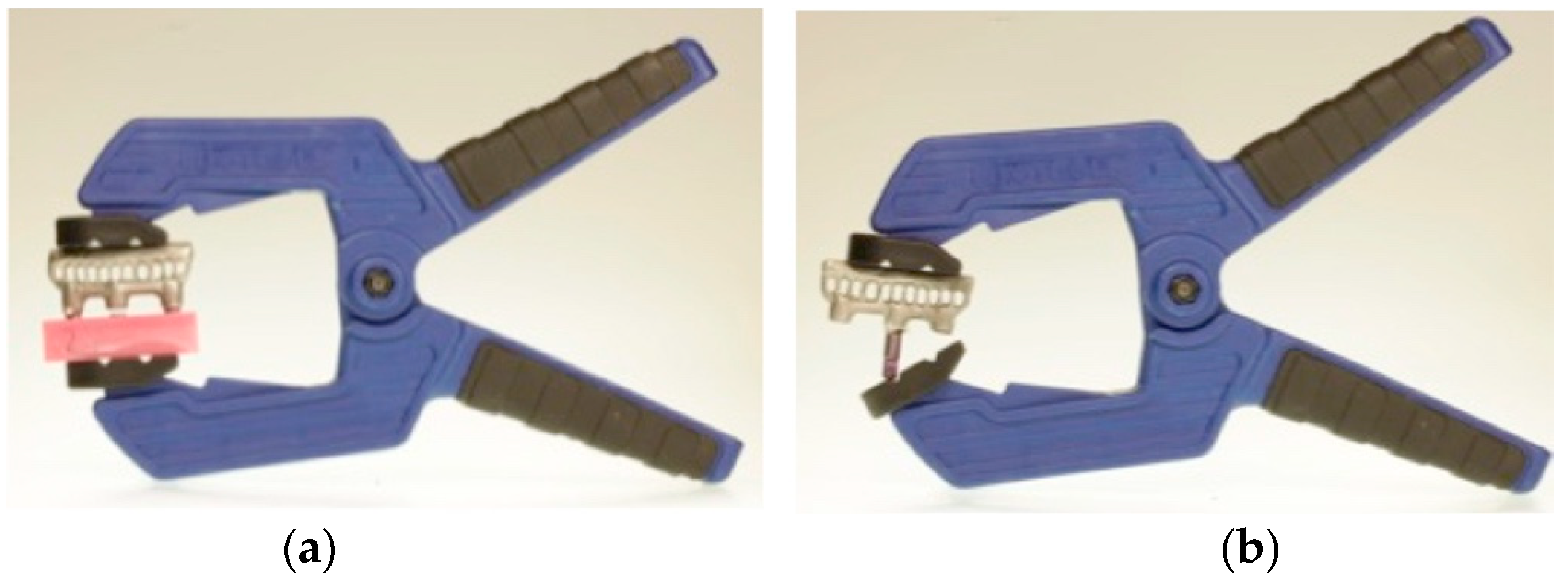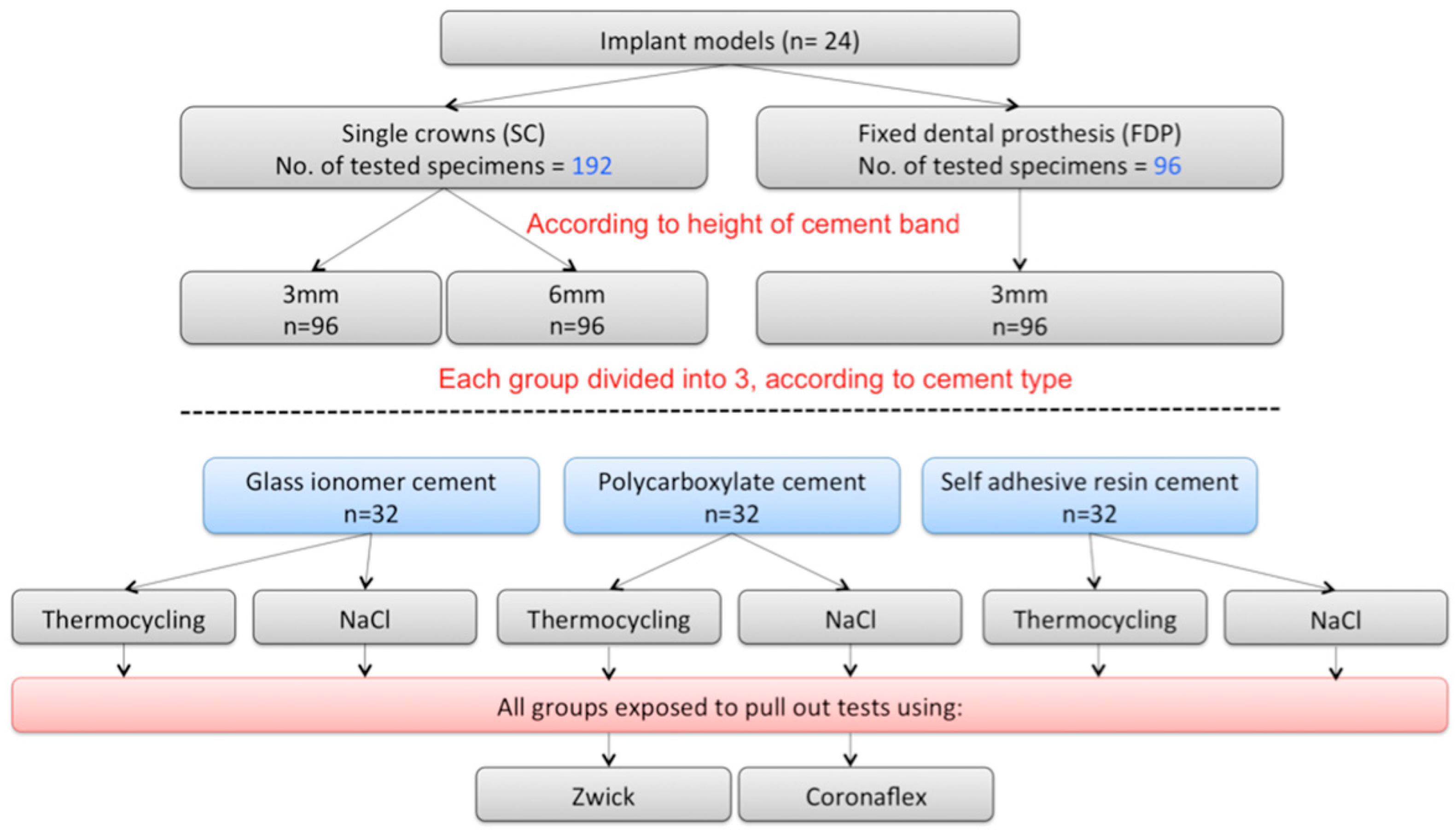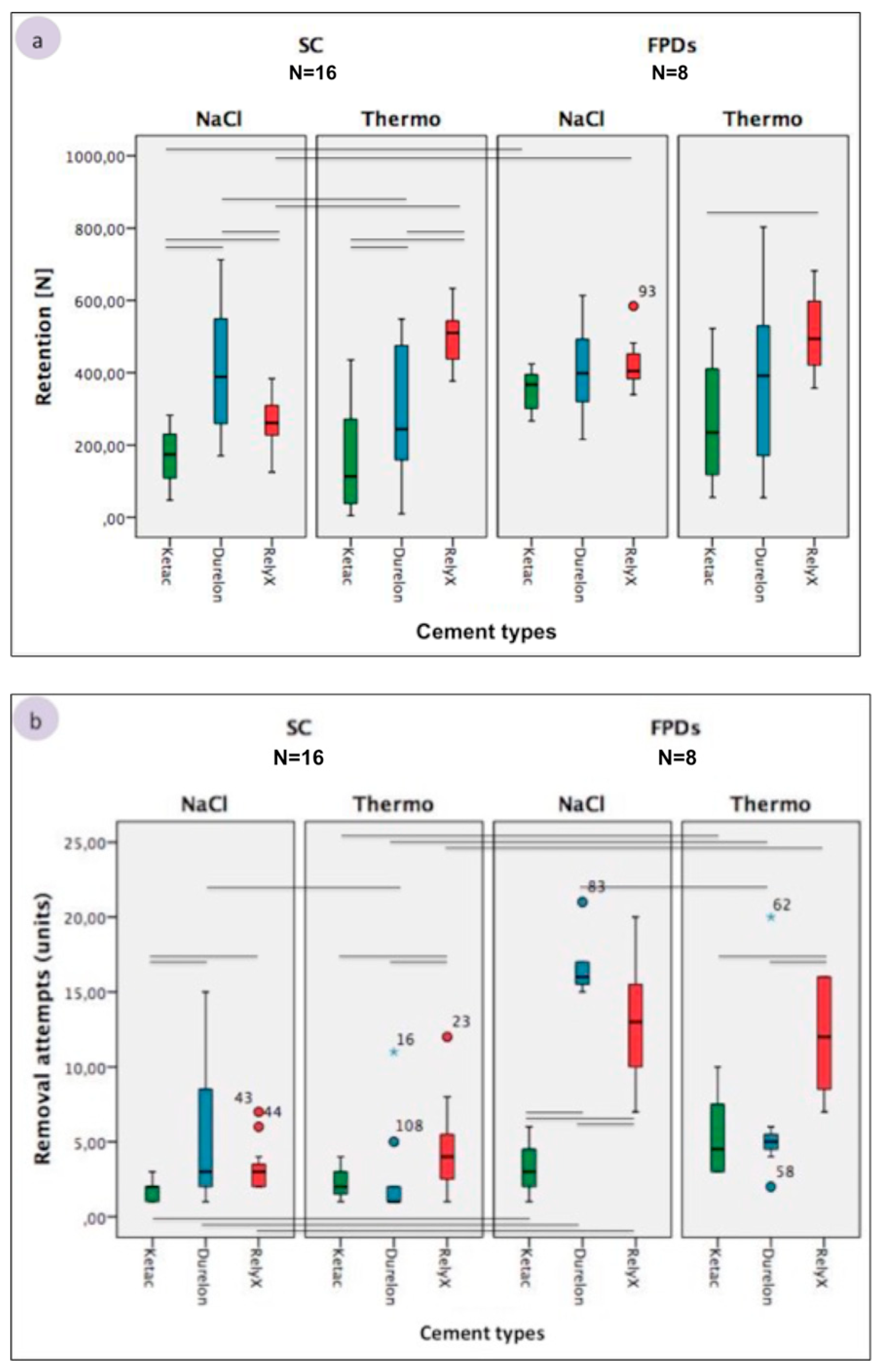Retention Forces of Implant-Supported Single Crowns and Fixed Dental Prostheses after Cementation: An In-Vitro Study
Abstract
1. Introduction
- There is no difference regarding the retention and removal attempts of SCs and FDPs.
- Thermocycling does not influence the retention of the cements.
2. Materials and Methods
2.1. Preparation of Implant Models
2.2. Preparation of Frameworks
2.3. Gap Measurement between Copings and Abutments
2.4. Cementation Procedure
2.5. Statistical Analysis
3. Results
4. Discussion
4.1. Crown-Abutment Gap
4.2. Restoration Material and Abrasion
4.3. Removal Technique
4.4. Type of Cement
5. Conclusions
- The type of restoration influences the retention and retrievability, as FDPs showed higher retention values and required an increased number of removal attempts in comparison to SCs.
- For SCs, artificial aging with thermocycling resulted in a significant increase in retention for RXU, whereas the retention of both KTC and DUR was decreased.
- Glass ionomer can be used as a semipermanent cement for both SCs and FDPs.
- Polycarboxylate cement can be considered as a semi-permanent cement after an aging period of one year.
Author Contributions
Funding
Institutional Review Board Statement
Informed Consent Statement
Acknowledgments
Conflicts of Interest
References
- Fueki, K.; Kimoto, K.; Ogawa, T.; Garrett, N.R. Effect of implant-supported or retained dentures on masticatory performance: A systematic review. J. Prosthet. Dent. 2007, 98, 470–477. [Google Scholar] [CrossRef]
- Bragger, U.; Burgin, W.B.; Hammerle, C.H.F.; Lang, N.P. Associations between clinical parameters assessed around implants and teeth. Clin. Oral Implants Res. 1997, 8, 412–421. [Google Scholar] [CrossRef] [PubMed]
- Derks, J.; Tomasi, C. Peri-implant health and disease. A systematic review of current epidemiology. J. Clin. Periodontol. 2015, 42 (Suppl. 16), S158–S171. [Google Scholar] [CrossRef] [PubMed]
- Kordbacheh Changi, K.; Finkelstein, J.; Papapanou, P.N. Peri-implantitis prevalence, incidence rate, and risk factors: A study of electronic health records at a U.S. dental school. Clin. Oral Implants Res. 2019, 30, 306–314. [Google Scholar] [CrossRef] [PubMed]
- Hamed, M.T.; Abdullah Mously, H.; Khalid Alamoudi, S.; Hossam Hashem, A.B.; Hussein Naguib, G. A Systematic Review of Screw versus Cement-Retained Fixed Implant Supported Reconstructions. Clin. Cosmet. Investig. Dent. 2020, 12, 9–16. [Google Scholar] [CrossRef]
- Ma, S.; Fenton, A. Screw-versus cement-retained implant prostheses: A systematic review of prosthodontic maintenance and complications. Int. J. Prosthodont. 2015, 28, 127–145. [Google Scholar] [CrossRef]
- Sherif, S.; Susarla, H.K.; Kapos, T.; Munoz, D.; Chang, B.M.; Wright, R.F. A systematic review of screw- versus cement-retained implant-supported fixed restorations. J. Prosthodont. 2014, 23, 1–9. [Google Scholar] [CrossRef]
- Wittneben, J.G.; Millen, C.; Bragger, U. Clinical performance of screw- versus cement-retained fixed implant-supported reconstructions—A systematic review. Int. J. Oral Maxillofac. Implants 2014, 29, 84–98. [Google Scholar] [CrossRef]
- Taylor, T.D.; Agar, J.R.; Vogiatzi, T. Implant prosthodontics: Current perspective and future directions. Int. J. Oral Maxillofac. Implants 2000, 15, 66–75. [Google Scholar]
- Chee, W.W.; Torbati, A.; Albouy, J.P. Retrievable cemented implant restorations. J. Prosthodont. 1998, 7, 120–125. [Google Scholar] [CrossRef]
- Zarb, G.A.; Schmitt, A. The longitudinal clinical effectiveness of osseointegrated dental implants: The Toronto study. Part III: Problems and complications encountered. J. Prosthet. Dent. 1990, 64, 185–194. [Google Scholar] [CrossRef]
- Keith, S.E.; Miller, B.H.; Woody, R.D.; Higginbottom, F.L. Marginal discrepancy of screw-retained and cemented metal-ceramic crowns on implants abutments. Int. J. Oral Maxillofac. Implants 1999, 14, 369–378. [Google Scholar] [PubMed]
- Gervais, M.J.; Wilson, P.R. A rationale for retrievability of fixed, implant-supported prostheses: A complication-based analysis. Int. J. Prosthodont. 2007, 20, 13–24. [Google Scholar] [PubMed]
- Torrado, E.; Ercoli, C.; Al Mardini, M.; Graser, G.N.; Tallents, R.H.; Cordaro, L. A comparison of the porcelain fracture resistance of screw-retained and cement-retained implant-supported metal-ceramic crowns. J. Prosthet. Dent. 2004, 91, 532–537. [Google Scholar] [CrossRef]
- Walton, J.N.; MacEntee, M.I. Problems with prostheses on implants: A retrospective study. J. Prosthet. Dent. 1994, 71, 283–288. [Google Scholar] [CrossRef]
- Duyck, J.; Naert, I. Influence of prosthesis fit and the effect of a luting system on the prosthetic connection preload: An in vitro study. Int. J. Prosthodont. 2002, 15, 389–396. [Google Scholar]
- Wood, M.R.; Vermilyea, S.G. A review of selected dental literature on evidence-based treatment planning for dental implants: Report of the Committee on Research in Fixed Prosthodontics of the Academy of Fixed Prosthodontics. J. Prosthet. Dent. 2004, 92, 447–462. [Google Scholar] [CrossRef]
- Chee, W.; Jivraj, S. Screw versus cemented implant supported restorations. Br. Dent. J. 2006, 201, 501–507. [Google Scholar] [CrossRef]
- Linkevicius, T.; Vindasiute, E.; Puisys, A.; Peciuliene, V. The influence of margin location on the amount of undetected cement excess after delivery of cement-retained implant restorations. Clin. Oral Implants Res. 2011, 22, 1379–1384. [Google Scholar] [CrossRef]
- Wilson, T.G., Jr. The positive relationship between excess cement and peri-implant disease: A prospective clinical endoscopic study. J. Periodontol. 2009, 80, 1388–1392. [Google Scholar] [CrossRef]
- Chee, W.; Felton, D.A.; Johnson, P.F.; Sullivan, D.Y. Cemented versus screw-retained implant prostheses: Which is better? Int. J. Oral Maxillofac. Implants 1999, 14, 137–141. [Google Scholar] [PubMed]
- Bresciano, M.; Schierano, G.; Manzella, C.; Screti, A.; Bignardi, C.; Preti, G. Retention of luting agents on implant abutments of different height and taper. Clin. Oral Implants Res. 2005, 16, 594–598. [Google Scholar] [CrossRef] [PubMed]
- Breeding, L.C.; Dixon, D.L.; Bogacki, M.T.; Tietge, J.D. Use of luting agents with an implant system: Part I. J. Prosthet. Dent. 1992, 68, 737–741. [Google Scholar] [CrossRef]
- Pan, Y.H.; Lin, C.K. The effect of luting agents on the retention of dental implant-supported crowns. Chang. Gung Med. J. 2005, 28, 403–410. [Google Scholar]
- Mehl, C.; Ali, S.; El Bahra, S.; Harder, S.; Vollrath, O.; Kern, M. Is There a Correlation Between Tensile Strength and Retrievability of Cemented Implant-Retained Crowns Using Artificial Aging? Int. J. Prosthodont. 2016, 29, 83–90. [Google Scholar] [CrossRef]
- Mehl, C.; Harder, S.; Wolfart, M.; Kern, M.; Wolfart, S. Retrievability of implant-retained crowns following cementation. Clin. Oral Implants Res. 2008, 19, 1304–1311. [Google Scholar] [CrossRef]
- Winkler, S.; Ring, K.; Ring, J.D.; Boberick, K.G. Implant screw mechanics and the settling effect: Overview. J. Oral Implantol. 2003, 29, 242–245. [Google Scholar] [CrossRef]
- Brawek, P.K.; Wolfart, S.; Endres, L.; Kirsten, A.; Reich, S. The clinical accuracy of single crowns exclusively fabricated by digital workflow-the comparison of two systems. Clin. Oral Investig. 2013, 17, 2119–2125. [Google Scholar] [CrossRef]
- Holmes, J.R.; Bayne, S.C.; Holland, G.A.; Sulik, W.D. Considerations in measurement of marginal fit. J. Prosthet. Dent. 1989, 62, 405–408. [Google Scholar] [CrossRef]
- Brunzel, S.; Yang, B.; Wolfart, S.; Kern, M. Tensile bond strength of a so-called self-adhesive luting resin cement to dentin. J. Adhes. Dent. 2010, 12, 143–150. [Google Scholar]
- Gale, M.S.; Darvell, B.W. Thermal cycling procedures for laboratory testing of dental restorations. J. Dent. 1999, 27, 89–99. [Google Scholar] [CrossRef]
- Xie, C.; Han, Y.; Zhao, X.Y.; Wang, Z.Y.; He, H.M. Microtensile bond strength of one- and two-step self-etching adhesives on sclerotic dentin: The effects of thermocycling. Oper Dent. 2010, 35, 547–555. [Google Scholar] [CrossRef] [PubMed]
- Mehl, C.; Harder, S.; Shahriari, A.; Steiner, M.; Kern, M. Influence of abutment height and thermocycling on retrievability of cemented implant-supported crowns. Int. J. Oral Maxillofac. Implants 2012, 27, 1106–1115. [Google Scholar] [PubMed]
- Schiessl, C.; Schaefer, L.; Winter, C.; Fuerst, J.; Rosentritt, M.; Zeman, F.; Behr, M. Factors determining the retentiveness of luting agents used with metal- and ceramic-based implant components. Clin. Oral Investig. 2013, 17, 1179–1190. [Google Scholar] [CrossRef]
- Wolfart, M.; Wolfart, S.; Kern, M. Retention forces and seating discrepancies of implant-retained castings after cementation. Int. J. Oral Maxillofac. Implants 2006, 21, 519–525. [Google Scholar]
- Mehl, C.; Harder, S.; Steiner, M.; Vollrath, O.; Kern, M. Influence of cement film thickness on the retention of implant-retained crowns. J. Prosthodont. 2013, 22, 618–625. [Google Scholar] [CrossRef]
- Albert, F.E.; El-Mowafy, O.M. Marginal adaptation and microleakage of Procera AllCeram crowns with four cements. Int. J. Prosthodont. 2004, 17, 529–535. [Google Scholar] [CrossRef]
- Ferrari, M. Cement thickness and microleakage under Dicor crowns: An in vivo investigation. Int. J. Prosthodont. 1991, 4, 126–131. [Google Scholar]
- Faot, F.; Suzuki, D.; Senna, P.M.; da Silva, W.J.; de Mattias Sartori, I.A. Discrepancies in marginal and internal fits for different metal and alumina infrastructures cemented on implant abutments. Eur. J. Oral Sci. 2015, 123, 215–219. [Google Scholar] [CrossRef]
- Nejatidanesh, F.; Shakibamehr, A.H.; Savabi, O. Comparison of Marginal and Internal Adaptation of CAD/CAM and Conventional Cement Retained Implant-Supported Single Crowns. Implant Dent. 2015, 25, 103–108. [Google Scholar] [CrossRef]
- Mehl, C.; Harder, S.; Schwarz, D.; Steiner, M.; Vollrath, O.; Kern, M. In vitro influence of ultrasonic stress, removal force preload and thermocycling on the retrievability of implant-retained crowns. Clin. Oral Implants Res. 2012, 23, 930–937. [Google Scholar] [CrossRef] [PubMed]
- Kern, M.; Thompson, V.P. Sandblasting and silica-coating of dental alloys: Volume loss, morphology and changes in the surface composition. Dent Mater 1993, 9, 151–161. [Google Scholar] [CrossRef]
- Akca, K.; Iplikcioglu, H.; Cehreli, M.C. Comparison of uniaxial resistance forces of cements used with implant-supported crowns. Int. J. Oral Maxillofac. Implants 2002, 17, 536–542. [Google Scholar] [PubMed]
- Mansour, A.; Ercoli, C.; Graser, G.; Tallents, R.; Moss, M. Comparative evaluation of casting retention using the ITI solid abutment with six cements. Clin. Oral Implants Res. 2002, 13, 343–348. [Google Scholar] [CrossRef]
- Moser, J.B.; Brown, D.B.; Greener, E.H. Short-Term Bond Strengths between Adhesive Cements and Dental Alloys. J. Dent. Res. 1974, 53, 1377–1386. [Google Scholar] [CrossRef]
- Worni, A.; Gholami, H.; Marchand, L.; Katsoulis, J.; Mericske-Stern, R.; Enkling, N. Retrievability of implant-supported crowns when using three different cements: A controlled clinical trial. Int. J. Prosthodont. 2015, 28, 22–29. [Google Scholar] [CrossRef][Green Version]
- Dudley, J.E.; Richards, L.C.; Abbott, J.R. Retention of cast crown copings cemented to implant abutments. Aust. Dent. J. 2008, 53, 332–339. [Google Scholar] [CrossRef]






| a | ||||
|---|---|---|---|---|
| Universal Testing Machine (UTM) | SCs | FDPs | ||
| NaCl (Mean ± SD) | Thermocycling (Mean ± SD) | NaCl (Mean ± SD) | Thermocycling (Mean ± SD) | |
| KTC | 170 ± 75 | 156 ± 134 | 352 ± 57 | 262 ± 178 |
| DUR | 409 ± 174 | 306 ± 175 | 406 ± 128 | 380 ± 247 |
| RXU | 265 ± 62 | 494 ± 70 | 426 ± 76 | 508 ± 122 |
| SD: Standard deviation. | ||||
| b | ||||
| CoronaFlex | SCs | FDPs | ||
| NaCl Median (Min/Max) | Thermocycling Median (Min/Max) | NaCl Median (Min/Max) | Thermocycling Median (Min/Max) | |
| KTC | 2 (1/3) | 2 (1/4) | 3 (1/6) | 5 (3/10) |
| DUR | 3 (1/15) | 1 (1/11) | 16 (15/21) | 5 (2/20) |
| RXU | 3 (2/7) | 4 (1/12) | 13 (7/20) | 12 (7/16) |
Publisher’s Note: MDPI stays neutral with regard to jurisdictional claims in published maps and institutional affiliations. |
© 2022 by the authors. Licensee MDPI, Basel, Switzerland. This article is an open access article distributed under the terms and conditions of the Creative Commons Attribution (CC BY) license (https://creativecommons.org/licenses/by/4.0/).
Share and Cite
Bishti, S.; Siouri, J.; Wolfart, S.; Tuna, T. Retention Forces of Implant-Supported Single Crowns and Fixed Dental Prostheses after Cementation: An In-Vitro Study. Oral 2022, 2, 29-40. https://doi.org/10.3390/oral2010005
Bishti S, Siouri J, Wolfart S, Tuna T. Retention Forces of Implant-Supported Single Crowns and Fixed Dental Prostheses after Cementation: An In-Vitro Study. Oral. 2022; 2(1):29-40. https://doi.org/10.3390/oral2010005
Chicago/Turabian StyleBishti, Shaza, Jousef Siouri, Stefan Wolfart, and Taskin Tuna. 2022. "Retention Forces of Implant-Supported Single Crowns and Fixed Dental Prostheses after Cementation: An In-Vitro Study" Oral 2, no. 1: 29-40. https://doi.org/10.3390/oral2010005
APA StyleBishti, S., Siouri, J., Wolfart, S., & Tuna, T. (2022). Retention Forces of Implant-Supported Single Crowns and Fixed Dental Prostheses after Cementation: An In-Vitro Study. Oral, 2(1), 29-40. https://doi.org/10.3390/oral2010005






